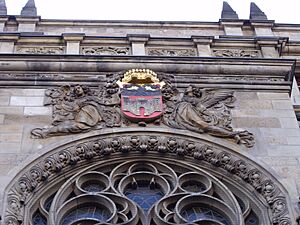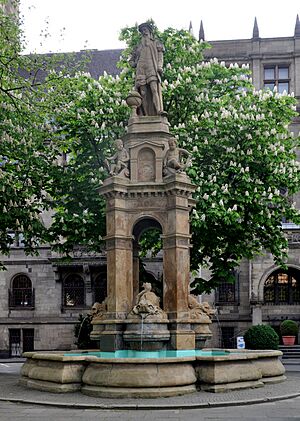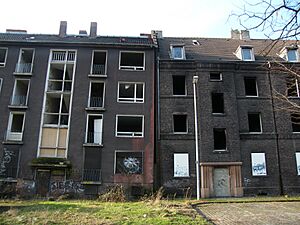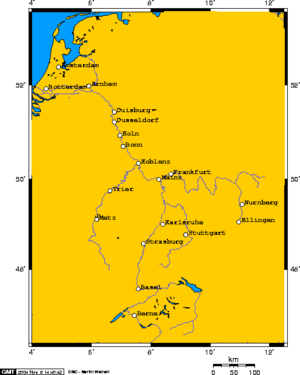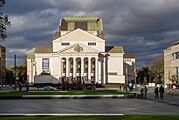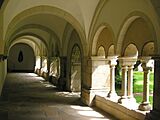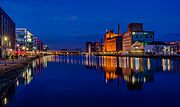Duisburg facts for kids
Quick facts for kids
Duisburg
Duisborg (Low German)
|
|||
|---|---|---|---|
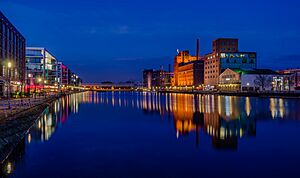
Duisburg Inner Harbour
|
|||
|
|||
| Country | Germany | ||
| State | North Rhine-Westphalia | ||
| Admin. region | Düsseldorf | ||
| District | Urban district | ||
| Elevation | 31 m (102 ft) | ||
| Population
(2022-12-31)
|
|||
| • City | 502,211 | ||
| • Metro | 8,711,712 (Rhineland) | ||
| Time zone | CET/CEST (UTC+1/+2) | ||
| Postal codes |
47001–47279
|
||
| Dialling codes | 0203 | ||
| Vehicle registration | DU | ||
| Website | www.duisburg.de | ||
Duisburg is a big city in western Germany. It's located where two important rivers, the Rhine and the Ruhr, meet. This makes Duisburg a very special place for shipping and trade. It's one of the largest cities in the German state of North Rhine-Westphalia.
In the past, Duisburg was an important trading city and a member of the Hanseatic League, a group of powerful trading towns. Later, it became famous for its iron, steel, and chemical factories. Today, Duisburg is home to the world's largest inland port, which is like a huge harbor for ships that travel on rivers and canals.
Contents
About Duisburg
Duisburg is a major city in Germany with about 500,000 people living there. It's the fifth-largest city in North Rhine-Westphalia, which is Germany's most populated state. Its location at the meeting point of the Rhine and Ruhr rivers is very important. This area is part of the larger Rhine-Ruhr Metropolitan Region, one of Europe's biggest city areas.
Duisburg is known for its huge inland port, called "Duisburg-Ruhrorter Häfen." This port helps move goods all over Europe. The city also has a large university, the University of Duisburg-Essen, with many students. Duisburg is still a big center for steel production. Many of Germany's blast furnaces, which make steel, are located here.
Geography
Duisburg is in a flat area called the Lowland Rhine. It sits right where the Rhine and Ruhr rivers come together. The city spreads out on both sides of these rivers.
Neighboring Cities
Duisburg shares borders with these cities:
- Oberhausen
- Mülheim an der Ruhr
- Ratingen
- Düsseldorf
- Meerbusch
- Krefeld
- Moers
- Rheinberg
- Dinslaken
City Districts
Since 1975, Duisburg has been divided into seven main areas, or boroughs. Here they are from north to south, with their approximate populations:
- Walsum (51,528 people)
- Hamborn (71,528 people)
- Meiderich/Beeck (73,881 people)
- Homberg/Ruhrort/Baerl (41,153 people)
- Duisburg-Mitte (center) (105,961 people)
- Rheinhausen (77,933 people)
- Duisburg-Süd (73,321 people)
Climate
Duisburg has a mild, oceanic climate, which means it doesn't get too hot or too cold. It often rains throughout the year. On July 25, 2019, Duisburg recorded the highest temperature ever in Germany: 41.2°C (106.2°F).
| Climate data for Duisburg | |||||||||||||
|---|---|---|---|---|---|---|---|---|---|---|---|---|---|
| Month | Jan | Feb | Mar | Apr | May | Jun | Jul | Aug | Sep | Oct | Nov | Dec | Year |
| Mean daily maximum °C (°F) | 4 (39) |
5 (41) |
8 (46) |
12 (54) |
17 (63) |
20 (68) |
22 (72) |
22 (72) |
18 (64) |
14 (57) |
8 (46) |
5 (41) |
13 (55) |
| Daily mean °C (°F) | 2 (36) |
3 (37) |
5 (41) |
8 (46) |
13 (55) |
16 (61) |
17 (63) |
17 (63) |
14 (57) |
11 (52) |
6 (43) |
3 (37) |
10 (49) |
| Mean daily minimum °C (°F) | 0 (32) |
0 (32) |
2 (36) |
5 (41) |
9 (48) |
12 (54) |
13 (55) |
13 (55) |
11 (52) |
8 (46) |
3 (37) |
1 (34) |
6 (44) |
| Average precipitation mm (inches) | 81.3 (3.20) |
55.9 (2.20) |
76.2 (3.00) |
68.6 (2.70) |
73.7 (2.90) |
96.5 (3.80) |
88.9 (3.50) |
76.2 (3.00) |
73.7 (2.90) |
71.1 (2.80) |
83.8 (3.30) |
88.9 (3.50) |
934.8 (36.8) |
| Source: weather.com | |||||||||||||
History of Duisburg
The name Duisburg might mean "fortified place in the floodplain" or "castle on the hill." The city's location on a hill overlooking the Rhine river was very important.
Early Times
Archaeological studies show that the main market square has been used since the first century. The city was on an important medieval trade route called the "Hellweg." It also had a ford (a shallow place to cross) over the Rhine, which the Romans protected.
- 420 AD: The Franks took over the Roman settlement.
- 883 AD: The Normans conquered Duisburg and stayed for the winter. This is the first time Duisburg is mentioned in historical writings.
Middle Ages
Because of its good location, a royal court was built in Duisburg. The town soon became a free city and joined the Hanseatic League, a powerful trading group. Around the year 1000, the Rhine river changed its path and moved away from the city. This slowed down Duisburg's growth as a trading town.
- 1120: A city wall was built around Duisburg.
- 1279: Duisburg was granted its "city charter" by King Lothar III.
- 1290: Duisburg became part of the Duchy of Cleves.
- 1566: Johannes Corputius finished his detailed city map of Duisburg.
- 1666: Duisburg, as part of the Duchy of Cleves, became part of Brandenburg-Prussia.
Industrial Age
In the 18th century, industries like tobacco and textiles grew, making Duisburg an industrial hub. Large companies, especially those making iron and steel like Thyssen and Krupp, greatly shaped the city. Many homes were built for workers and their families who moved to Duisburg.
- 1824: The first sulfuric acid factory was built, marking the start of the industrial age in Duisburg.
- 1828: Franz Haniel built a dockyard for steamships.
- 1846-1847: Railway lines connected Duisburg to other major cities like Düsseldorf and Dortmund.
- 1904: The city's 100,000th resident was born.
- 1929: The city of Hamborn joined Duisburg, and the new city was called Duisburg-Hamborn.
- 1935: The city was renamed simply Duisburg.
- 1938: During November, the city's synagogue was destroyed by the Nazis.
World War II and After
Duisburg was a very important industrial center during World War II. Because of its factories and transport links, it was a main target for Allied bombers. The city suffered heavy damage from bombing raids.
- 1943: A large bombing raid destroyed much of the old city. Many people lost their homes.
- 1945: Allied ground forces reached Duisburg and captured the city on April 12. After the war, a railway bridge across the Rhine was built in record time, called the "Victory Bridge."
After the war, most of Duisburg's historic buildings were destroyed. About 80% of all homes were damaged or ruined. The city had to be almost completely rebuilt.
From the mid-1960s, the steel and mining industries in Duisburg started to decline. This led to a decrease in the number of people living in the city.
- 1983: Duisburg celebrated its 1100th anniversary.
- 2005: The city hosted the 7th World Games, a big international sports event.
- 2010: A sad event happened at the Love Parade festival, where a crowd panic led to 21 deaths and many injuries.
Population
In 2010, Duisburg had about 489,600 people. The city has a diverse population, with many residents from different countries.
| Historical population | ||
|---|---|---|
| Year | Pop. | ±% |
| 1714 | 2,983 | — |
| 1810 | 5,195 | +74.2% |
| 1871 | 30,533 | +487.7% |
| 1900 | 92,729 | +203.7% |
| 1910 | 229,483 | +147.5% |
| 1919 | 244,302 | +6.5% |
| 1925 | 272,252 | +11.4% |
| 1933 | 440,419 | +61.8% |
| 1939 | 434,646 | −1.3% |
| 1950 | 410,783 | −5.5% |
| 1961 | 504,975 | +22.9% |
| 1970 | 454,839 | −9.9% |
| 1975 | 591,635 | +30.1% |
| 1980 | 558,089 | −5.7% |
| 1985 | 518,260 | −7.1% |
| 1990 | 535,447 | +3.3% |
| 2001 | 512,030 | −4.4% |
| 2011 | 488,468 | −4.6% |
| 2022 | 501,415 | +2.7% |
| Population size may be affected by changes in administrative divisions. source: | ||
Many people from Turkey live in Duisburg, making up a large part of the city's population. Other groups include people from Bulgaria, Syria, Ukraine, and Romania.
Transportation
Duisburg Port
Duisburg is home to the world's largest inland port, called "Duisburg-Ruhrorter Häfen." It's so big that it's even considered a "seaport" because ships can travel from here to ports in Europe, Africa, and the Middle East.
- Over 40 million tons of goods are moved through the port each year.
- More than 20,000 ships visit the port annually.
- The port has 21 docks and 40 kilometers (about 25 miles) of wharf.
- It's also the biggest inland container port, handling millions of large shipping containers.
Roads
Duisburg is well-connected by several major highways, called autobahns in Germany.
- The A3 goes around the east side of the city.
- The A59 runs north to south through the city.
- The A40 and A42 are important east-west routes.
These highways help people travel easily within Duisburg and to other cities.
Public Transport
Duisburg has a good public transport system:
- Trains: Duisburg Hauptbahnhof (main station) is served by fast ICE trains and regional S-Bahn trains, connecting Duisburg to other cities in the Rhine-Ruhr area.
- Trams and Buses: The city has a network of trams and buses, all run by the Duisburger Verkehrsgesellschaft. One tram line, the U79, even connects Duisburg to the neighboring city of Düsseldorf.
Media
Duisburg has several local newspapers that report on city news and politics, such as the Westdeutsche Allgemeine (WAZ) and the Neue Ruhr Zeitung (NRZ).
- Radio: "Radio Duisburg" was the first local radio station in North Rhine-Westphalia, starting in 1990.
- Television: "STUDIO 47" is a local TV station that began broadcasting in 2006. The WDR, a larger German TV and radio network, also produces local programs for Duisburg.
Culture
Duisburg offers many cultural activities and places to visit.
- Duisburger Akzente: This is an annual festival that focuses on modern social, political, and cultural topics.
- Opera and Orchestra: Duisburg shares the Deutsche Oper am Rhein, a major opera house, with Düsseldorf. The Duisburg Philharmonic Orchestra is also well-known internationally.
- Museums and Architecture: The city has interesting buildings and museums, like the German Inland Waterways Museum. You can see old churches, like St. Johann Baptist (built around 900 AD), and modern buildings.
- Landschaftspark Duisburg-Nord: This is a unique park built on an old industrial site. It's a great example of how old factories can be turned into public spaces.
- Gardens and Parks: Duisburg has two botanical gardens, the Botanischer Garten Duisburg-Hamborn and the Botanischer Garten Kaiserberg, plus many other city parks.
Sports
Duisburg is active in many sports. The most popular sport for its residents is football, with the local club MSV Duisburg.
- MSV-Arena: The city has a modern sports stadium, the MSV-Arena, used for football and American football.
- World Games: In 2005, Duisburg hosted the World Games, a big international sports event.
- Football Teams: During the 2006 FIFA World Cup, the Portuguese and Italian national football teams stayed and trained in Duisburg.
- Water Sports: Duisburg is also known for its Rhein-Ruhr-Marathon, and for rowing and canoeing regattas, including world championships.
- Other Sports: Other popular sports include ice hockey, basketball, water polo, and field hockey.
| Club | Sport | League | Venue |
|---|---|---|---|
| MSV Duisburg | Football | 3. Liga | MSV-Arena |
| Rhein Fire | American football | European League of Football (ELF) | MSV-Arena |
| Füchse Duisburg | Ice hockey | Oberliga (3rd District League) | PreZero Rheinlandhalle |
| MSV-Duisburg | Women's football | Women's Bundesliga | MSV-Arena |
| Duisburg Dockers | Baseball, American football | Landesliga II (2nd District League) | Schwelgernstadion |
| Amateur SC Duisburg | Water polo | Deutsche Wasserball-Liga (1st Water Polo League) | Schwimmstadion and club pool |
| Club Raffelberg | Hockey | Regionalliga West (3rd Hockey League) | Kalkweg |
Famous People from Duisburg
Many notable people have come from Duisburg:
- Gerardus Mercator (1512–1594), a famous mapmaker who invented the Mercator projection.
- Wilhelm Lehmbruck (1881–1919), a well-known sculptor.
- August Thyssen (1842–1926), an important industrialist.
- Paul Bäumer (1896–1927), a World War I flying ace.
- Dieter Kürten (born 1935), a sports journalist.
- Frank Peter Zimmermann (born 1965), a talented violinist.
- Ramin Djawadi (born 1974), a composer and music producer, known for film scores.
- André Lotterer (born 1981), a racing driver.
- Ena Mahmutovic (born 2003), a footballer.
Sister Cities
Duisburg has "sister city" relationships with several cities around the world. This means they work together to promote cultural exchange and friendship.
 Portsmouth, England, UK (since 1950)
Portsmouth, England, UK (since 1950) Calais, France (since 1964)
Calais, France (since 1964) Wuhan, China (since 1982)
Wuhan, China (since 1982) Vilnius, Lithuania (since 1985)
Vilnius, Lithuania (since 1985) Gaziantep, Turkey (since 2005)
Gaziantep, Turkey (since 2005) Perm, Russia (since 2007)
Perm, Russia (since 2007) San Pedro Sula, Honduras (since 2008)
San Pedro Sula, Honduras (since 2008) Lomé, Togo (since 2010)
Lomé, Togo (since 2010) Fort Lauderdale, United States (since 2011)
Fort Lauderdale, United States (since 2011) Kryvyi Rih, Ukraine (since 2023)
Kryvyi Rih, Ukraine (since 2023)
Images for kids
See also
 In Spanish: Duisburgo para niños
In Spanish: Duisburgo para niños




